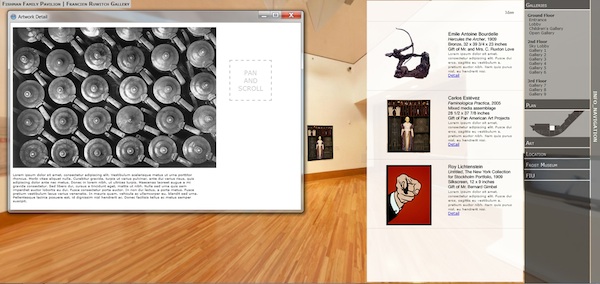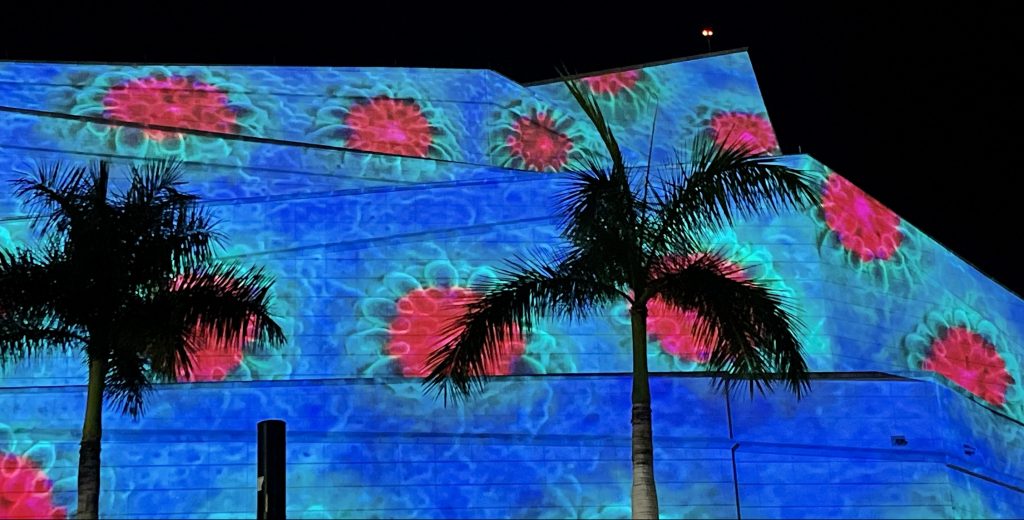
Art museum expands online with “Virtual Frost”
Cross posted from fiusm.com, student media at Florida International University By: Heather Armas, contributing writer
Starting in August, the Patricia & Phillip Frost Art Museum will open its virtual museum doors.
The vision for the Virtual Frost project was a collaborative effort between Dr. Carol Damian, director and chief curator of the Frost Art Museum and the Curatorial Team and Educational Department at the Frost Art Museum. In November of 2010, the Frost Art Museum initially applied for a Knight Arts Challenge Grant with the John S. and James L. Knight Foundation to help pay for a vision of creating a 100 percent virtual museum experience for the public.
The money received from this grant was substantial, but it only allowed the Frost to complete the initial phase of the project—to date only two of the nine galleries online.
Hoping to expand the virtual museum to include all nine galleries currently on display, the Frost applied for the Inktel Direct Innovation Grant. The museum has been selected as a preliminary finalist and will know by Aug. 5 if they have made it to the finals.
“It’s a very exciting opportunity for the Art museum, which will be the only truly virtual museum in the entire Southeastern United States,” said Kelly Brady-Rumble, the Museum’s grants specialist.
This venture will allow people from all over the world to view the artwork on display. The population that the museum is hoping to serve will include any member of the public who is interested in viewing and researching art or simply wants to experience a visit to a virtual art museum.
The Virtual Frost will also allow the museum to do podcasts, webcasts, virtual tours, lectures and other events. “We are excited because going virtual allows us to not only advance into the highest levels of technology, but also reach beyond our walls,” said Damian. “FIU is not always easy to get to and it has been proven that a virtual introduction actually inspires people to see the real thing. We can program to actually curate exhibits from our collection in our own galleries and then do a walk-thru online. Also, we are in the process of digitizing every work in our collection to put online. This is important for research and especially for student projects and exhibitions.”
Using social media—4square, Facebook and Google Panoramio, a website that enables photos taken at the Frost Art Museum to geo-locate and be a part of the experience in Google Earth and Google Maps—the Frost museum communicates with the community to let them know about museum exhibitions, events, etc.
“We use these networking tools to encourage creative and cultural dialogue among people and the museum but also to inform and educate,” explained Brady-Rumble. “You do not have access to the virtual museum through Facebook, but you would definitely be able to find out about museum events, read blogs and chat with others who have visited the virtual museum. From there you will be able to log into the Frost website and visit the Virtual Frost.”
“The possibility of taking the tour with mobile devices such as electronic tablets and smart phones provides an extra level of interaction we are preparing and it will be interesting for users to walk through the museum and see in real time what the galleries look like,” said Mauricio Gonzalez, a junior architecture major.
Gonzalez, who is in charge of designing the virtual museum, is one of the students working closely with Malik Benjamin, a visiting instructor at the School of Architecture.
The process was grueling: The artwork of all nine galleries was taken down to take pictures of the blank walls, then the artwork was hung up again to take pictures of the wall with the artwork. With the pictures of the blank walls on file, they are able to put up new artworks as they come up.
“Personally I think it has been an interesting process so far because we were not trained as web designers, but [as] architects,” Gonzalez said. “Yet, given our background [as architect majors] we can also let our imagination pursue very exciting ideas for the virtual spatial experience of the museum.”
Brady-Rumble agreed.
“The museum is also hoping to add music to the exhibits that will correlate with the art and the mood a certain gallery is conveying. This is a very exciting and cool opportunity for the Frost.”
Brady-Rumble also mentioned that at some point the Frost and Virtual Frost would even like to show the behind the scenes efforts of the museum, sharing information on how paintings are restored as well as the outdoor sculpture park.
“When this is finished and reaches the point where everyone is able to have access to the museum, they will see how amazing the space is,” said Marilyn Roa, a junior architecture major.
Roa’s tasks consist of taking photographs of the art on display and helping with the web design of the museum. “I’m sure the students and people from outside the [University’s] community will finally say ‘yes, I’ve gone there and love it/hate it,’” Roa said. “Regardless of what they finally think about the museum, the point is to bring people inside and have their opinion, because, after all, that’s what art is.”
Recent Content
-
Artsarticle ·
-
Artsarticle ·
-
Artsarticle ·

